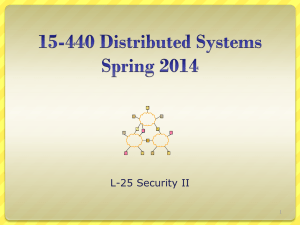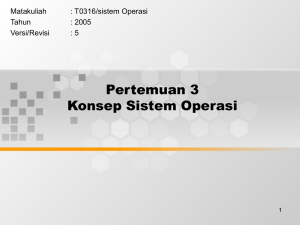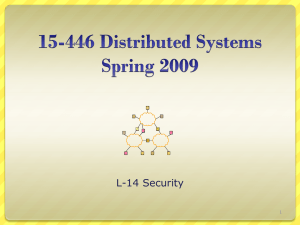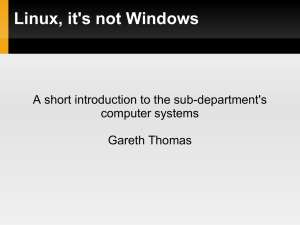L-25 Security II 1
advertisement
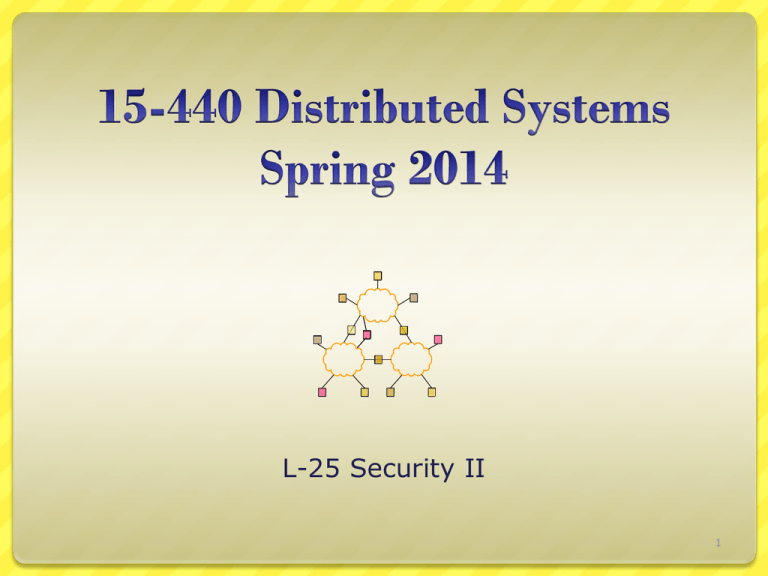
L-25 Security II
1
Today's Lecture
Effective secure channels
Access control
Privacy and Tor
2
The Great Divide
Symmetric Crypto:
(Private key)
Example: AES
Requires a preshared secret
between
communicating
parties?
Overall speed of
cryptographic
operations
Yes
Fast
Asymmetric
Crypto:
(Public key)
Example: RSA
No
Slow
3
Certification Authorities
Certification authority (CA): binds public
key to particular entity, E.
An entity E registers its public key with CA.
E provides “proof of identity” to CA.
CA creates certificate binding E to its public key.
Certificate contains E’s public key AND the CA’s
signature of E’s public key.
Bob’s
public
key
Bob’s
identifying
information
CA generates
S = Sign(KB)
KB
CA
private
key
K-1
CA
KB
certificate = Bob’s
public key and
signature by CA
4
Certification Authorities
When Alice wants Bob’s public key:
Gets Bob’s certificate (Bob or elsewhere).
Use CA’s public key to verify the signature
within Bob’s certificate, then accepts public
key
KB
If signature
is valid, use
KB
Verify(S, KB)
CA
public
key
KCA
5
Certificate Contents
info algorithm and key value itself (not shown)
Cert owner
Cert issuer
Valid dates
Fingerprint of
signature
6
Transport Layer Security (TLS)
aka Secure Socket Layer (SSL)
Used for protocols like HTTPS
Special TLS socket layer between application
and TCP (small changes to application).
Handles confidentiality, integrity, and
authentication.
Uses “hybrid” cryptography.
7
Setup Channel with TLS “Handshake”
Handshake Steps:
1) Clients and servers negotiate
exact cryptographic protocols
2) Client’s validate public key
certificate with CA public key.
3) Client encrypt secret random
value with servers key, and
send it as a challenge.
4) Server decrypts, proving it
has the corresponding
private key.
5) This value is used to derive
symmetric session keys for
encryption & MACs.
8
How TLS Handles Data
1) Data arrives as a stream from the application via the TLS Socket
2) The data is segmented by TLS into chunks
3) A session key is used to encrypt and MAC each chunk to form a TLS
“record”, which includes a short header and data that is encrypted, as
well as a MAC.
4) Records form a byte stream that is fed to a TCP socket for
transmission.
9
Analysis
Public key lets us take the trusted third party offline:
If it’s down, we can still talk!
But we trade-off ability for fast revocation
If server’s key is compromised, we can’t revoke it
immediately...
Usual trick:
Certificate expires in, e.g., a year.
Have an on-line revocation authority that distributes a revocation list.
Kinda clunky but mostly works, iff revocation is rare. Clients fetch list
periodically.
Better scaling: CA must only sign once... no matter
how many connections the server handles.
If CA is compromised, attacker can trick clients into
thinking they’re the real server.
10
Important Lessons
Symmetric (pre-shared key, fast) and
asymmetric (key pairs, slow) primitives
provide:
Confidentiality
Integrity
Authentication
“Hybrid Encryption” leverages strengths of
both.
Great complexity exists in securely acquiring
keys.
Crypto is hard to get right, so use tools from
others, don’t design your own (e.g. TLS).
11
Forward secrecy
In KDC design, if key Kserver-KDC is
compromised a year later,
from the traffic log, attacker can extract session
key (encrypted with auth server keys).
attacker can decode all traffic retroactively.
In SSL, if CA key is compromised a year
later,
Only new traffic can be compromised. Cool…
But in SSL, if server’s key is compromised...
Old logged traffic can still be compromised...
12
Diffie-Hellman Key Exchange
Different model of the world: How to generate
keys between two people, securely, no trusted
party, even if someone is listening in.
image from wikipedia
This is cool. But: Vulnerable to man-in-themiddle attack. Attacker pair-wise negotiates
keys with each of A and B and decrypts traffic
in the middle. No authentication...
13
Authentication?
But we already have protocols that give us
authentication!
They just happen to be vulnerable to disclosure if long-lasting
keys are compromised later...
Hybrid solution:
Use diffie-hellman key exchange with the protocols we’ve
discussed so far.
Auth protocols prevent M-it-M attack if keys aren’t yet
compromised.
D-H means that an attacker can’t recover the real session key
from a traffic log, even if they can decrypt that log.
Client and server discard the D-H parameters and session key
after use, so can’t be recovered later.
This is called “perfect forward secrecy”. Nice property.
14
One more note…
public key infrastructures (PKI)s are great,
but have some challenges…
Yesterday, we discussed how your browser trusts
many, many different CAs.
If any one of those is compromised, an attacker
can convince your browser to trust their key for a
website... like your bank.
Often require payment, etc.
Alternative: the “ssh” model, which we call
“trust on first use” (TOFU). Sometimes
called “prayer.”
15
Today's Lecture
Effective secure channels
Access control
Privacy and Tor
16
Access Control
Once secure communication between a
client and server has been established, we
now have to worry about access control –
when the client issues a request, how do we
know that the client has authorization?
17
The Access Control Matrix (ACM)
A model of protection systems
Describes who (subject) can do what
(rights) to what/whom (object/subject)
Example
An instructor can assign and grade homework
and exams
A TA can grade homework
A Student can evaluate the instructor and TA
18
18
An Access Control Matrix
Allowed Operations (Rights): r,x,w
Ann
Bob
Charlie
File1
rx
rwx
rx
File2
r
r
rw
File3
rwx
-w
19
ACMs and ACLs; Capabilities
Real systems have to be fast and not use
excessive space
20
What’s Wrong with an ACM?
If we have 1k ‘users’ and 100k ‘files’ and a
user should only read/write his or her own
files
The ACM will have 100k columns and 1k rows
Most of the 100M elements are either empty or
identical
Good for theoretical study but bad for
implementation
Remove the empty elements?
21
21
Two ways to cut a table (ACM)
Order by columns (ACL) or rows (Capability
Lists)?
Ann
Bob
Charlie
File1
rx
rwx
rx
File2
r
r
rw
File3
rwx
-w
ACLs
Capability
22
Access Control Lists
An ACL stores (non-empty elements of) each
column with its object
Columns of access control matrix
Andy
Betty
Charlie
File1
rx
File2
r
File3
rwx
rwx
rx
r
rw
-w
ACLs:
file1: { (Andy, rx) (Betty, rwx) (Charlie, rx) }
file2: { (Andy, r) (Betty, r) (Charlie, rw) }
file3: { (Andy, rw) (Charlie, w) }
23
23
Capability Lists
Rows of access control matrix
Andy
Betty
Charlie
File1
rx
rwx
rx
File2
r
r
rw
File3
rwx
-w
C-Lists:
Andy: { (file1, rx) (file2, r) (file3, rw) }
Betty: { (file1, rwx) (file2, r) }
Charlie: { (file1, rx) (file2, rw) (file3, w) }
24
24
ACL:Default Permission and
Abbreviation
Example: UNIX
Three classes of users: owner, group, all others
25
25
Capability
Like a bus ticket
Mere possession indicates rights that subject has over
object
Object identified by capability (as part of the token)
Name may be a reference, location, or something else
The key challenge is to prevent process/user from
altering capabilities
Otherwise a subject can augment its capabilities at will
Cryptography
Associate with each capability a cryptographic
checksum enciphered using a key known to OS
When process presents capability, OS validates
checksum
26
26
Delegation (1)
The general structure of a proxy as used for
delegation.
27
Delegation (2)
Using a proxy to delegate and prove ownership
of access rights.
28
ACLs vs. Capabilities
They are equivalent:
1. Given a subject, what objects can it access, and
how?
2. Given an object, what subjects can access it, and
how?
ACLs answer second easily; C-Lists, answer the first
easily.
The second question in the past was most
used; thus ACL-based systems are more
common
But today some operations need to answer
the first question
29
Today's Lecture
Effective secure channels
Access control
Privacy and Tor
30
Randomized Routing
Hide message source by routing it randomly
Popular technique: Crowds, Freenet, Onion routing
Routers don’t know for sure if the apparent
source of a message is the true sender or
another router
31
Onion Routing
R
R
R1
Alice
R
R2
R3
R4
R
R
R
Bob
Sender chooses a random sequence of routers
Some routers are honest, some controlled by attacker
Sender controls the length of the path
32
Route Establishment
R2
Alice
R1
{R2,k1}pk(R1),{
{R3,k2}pk(R2),{
R3
{R4,k3}pk(R3),{
R4
{B,k4}pk(R4),{
{M}pk(B)
Bob
} k4
} k3
} k2
} k1
Routing info for each link encrypted with router’s public key
Each router learns only the identity of the next router
33
How does Tor work?
34
How does Tor work?
35
Tor Circuit Setup (1)
Client proxy establish a symmetric session key
and circuit with Onion Router #1
36
Tor Circuit Setup (2)
Client proxy extends the circuit by establishing
a symmetric session key with Onion Router #2
Tunnel through Onion Router #1
37
Tor Circuit Setup (3)
Client proxy extends the circuit by establishing a
symmetric session key with Onion Router #3
Tunnel through Onion Routers #1 and #2
38
Using a Tor Circuit
Client applications connect and communicate
over the established Tor circuit
39
Location Hidden Servers
Goal: deploy a server on the Internet that anyone
can connect to without knowing where it is or who
runs it
Accessible from anywhere
Resistant to censorship
Can survive full-blown DoS attack
Resistant to physical attack
Can’t find the physical server!
40
Creating a Location Hidden Server
Server creates onion routes
to “introduction points”
Client obtains service
descriptor and intro point
address from directory
Server gives intro points’
descriptors and addresses
to service lookup directory
41
Using a Location Hidden Server
Client creates onion route
to a “rendezvous point”
Rendezvous point
mates the circuits
from client & server
If server chooses to talk to client,
connect to rendezvous point
Client sends address of the
rendezvous point and any
authorization, if needed, to
server through intro point
42
Tor
Second-generation onion routing network
http://tor.eff.org
Developed by Roger Dingledine, Nick Mathewson
and Paul Syverson
Specifically designed for low-latency anonymous
Internet communications
Running since October 2003
100s nodes on four continents, thousands of
users
“Easy-to-use” client proxy
Freely available, can use it for anonymous browsing
43
